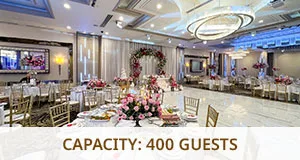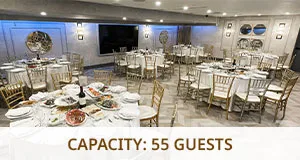Congratulations on your engagement! Now comes the exciting part: planning your wedding. One of the first questions couples face is: How do you budget for a wedding? It’s easy to feel overwhelmed, but the truth is, creating a wedding budget isn’t about restricting your dreams; it’s about knowing how to spend wisely so you can enjoy your day without financial stress.
In this guide, we’ll break down how to set a realistic budget, divide it into categories, and avoid common mistakes. And if you’re tying the knot in Los Angeles, venues like Banquet Halls LA can help with budget friendly wedding venues and all-inclusive packages that simplify planning.

Why Your Wedding Budget Matters
Talking about money may not feel romantic, but it’s one of the smartest things you can do early in your planning. A well-thought-out wedding budget is more than a spreadsheet; it’s a tool that gives you confidence and direction. Here’s why it matters:
- It sets realistic expectations. Without a budget, it’s easy to fall in love with a $10,000 floral design when you only planned to spend $3,000 on décor. Agreeing on numbers helps you and your families stay aligned from the start.
- It defines your priorities. Every couple values different things: some care more about food and music, others about photography or fashion. Your budget lets you decide where to spend more and where to spend less.
- It reduces last-minute stress. Many couples forget about hidden costs like taxes, gratuities, or vendor tips. Building these into your budget keeps you from panicking when final bills arrive.
Think of your budget as your wedding’s roadmap: it keeps you pointed toward your dream celebration, while making sure you don’t take costly detours along the way.
The Golden Rule: Set Your Total Budget First
Before you start dividing money into categories, you need to know your total number. This is your foundation, the figure that everything else will build on. It might come from personal savings, help from family, or even a combination of both.
Be honest with yourselves about what feels comfortable. Stretching too far will only add stress, while setting a realistic number makes every decision easier.
For example, let’s say your total wedding budget is $30,000. By knowing that upfront, you can quickly decide:
- $12,000–$15,000 goes toward venue and catering
- $3,000–$4,500 for photography and videography
- $1,500–$3,000 for attire and beauty
This way, you’re not falling in love with a $7,000 photographer before realizing you don’t have room left for other essentials. Starting with the big number keeps your spending balanced and prevents tough decisions later on.

Breaking Down the Wedding Budget by Category
1. Venue, Catering & Rentals (40–50%)
This is usually the largest slice of your budget, and it makes sense. The venue sets the tone for your day, and food and drinks are what guests remember most. This category includes the rental of the space, catering, drinks, tables, chairs, linens, lighting, and sometimes parking.
A key way to save is to host both your ceremony and reception at the same venue. Doing this avoids paying for two separate rentals, transportation for guests, and duplicate décor.
Many couples also choose all-inclusive venues like Banquet Halls LA, where catering, décor, staff, and coordination are bundled into one package. That means fewer contracts to juggle and fewer hidden costs to worry about, making it easier to stay within your wedding budget.
2. Photography & Videography (10–15%)
Your wedding day goes by in a flash, but photos and video preserve it forever. Set aside enough here for experienced professionals who know how to capture candid emotions as well as the big “wow” moments.
Pro tip: ask photographers about packages that include engagement photos. It’s not just about more pictures—it’s also a chance to get comfortable in front of the camera before the big day.
If you’re marrying locally, Los Angeles has incredible wedding photoshoot locations—from beaches to gardens and iconic city spots. Keep in mind that permits or extra time for travel may add to your wedding budget, so plan ahead.
3. Attire & Beauty (5–10%)
This is where you invest in how you’ll look and feel on your big day. Wedding dress, tuxedo or suit, shoes, jewelry, alterations, and beauty all fall here. Don’t forget trials for hair and makeup; these can cost several hundred dollars if not budgeted for.
Another way to manage costs is to look for sample sales, trunk shows, or even secondhand options for attire. For makeup and hair, group packages for bridesmaids can sometimes reduce the price per person.

4. Entertainment (5–10%)
Music at a wedding seems almost required. You could pick a DJ, a live band, or maybe a small group for the ceremony. DJs often appear cheaper, while bands may bring an energy that some thinks justifies the higher price. If money is tight, why not try a hybrid? A live player for the ceremony and cocktail hour, then a DJ for the reception. That option might give both live feel and some savings in the end.
5. Flowers & Décor (5–10%)
Décor transforms a room, but it can also get expensive. Bouquets, boutonnieres, centerpieces, arches, and backdrops quickly add up.
Smart ways to save:
- Repurpose ceremony flowers at the reception.
- Mix greenery and candles with smaller floral arrangements.
- Choose flowers that are in season—they’re cheaper and last longer.
This is also an area where the right venue can reduce costs. If you book a ballroom that already has chandeliers, draping, or stylish architecture, you may need less décor overall.
6. Planner/Coordinator (5–10%)
Some couples hesitate to hire a planner, thinking it’s unnecessary. But a good planner or day-of coordinator can actually save you money. They often have vendor relationships that unlock better deals, and they help you avoid costly mistakes—like paying overtime fees because of a mismanaged schedule.
If a full-service planner isn’t in your budget, consider a month-of or day-of coordinator. You still get professional help, but at a fraction of the cost.
7. Invitations, Stationery & Favors (2–5%)
This category covers save-the-dates, invitations, RSVP cards, programs, menus, signage, and thank-you cards. Paper and printing costs add up faster than most couples expect.
If you want to cut down, digital invitations are an eco-friendly and budget-friendly choice. For favors, many couples now choose edible gifts or donate to a charity instead of traditional trinkets, which often go unused.
8. Miscellaneous & Unexpected Costs (5–10%)
Even the most detailed budgets face surprises. From vendor tips and transportation to last-minute décor fixes, this category ensures you’re prepared.
Some common expenses couples forget to include:
- Marriage license fees
- Overtime charges for photographers, DJs, or venues
- Beauty touch-ups (like extra lipstick or hair spray)
- Guest transportation or shuttle service
Setting aside 5–10% of your budget here acts as a safety net, so you’re not scrambling when the unexpected happens.
Keep in mind: these percentages are flexible ranges, not fixed numbers. If you spend at the higher end on one category (like 50% on venue and catering), you’ll likely need to stay at the lower end for others. The goal is for everything to add up to 100% of your total wedding budget.

Tips for Making Your Wedding Budget Work
Even with a clear budget in place, it’s easy to get sidetracked by upgrades, extras, and unexpected temptations. The secret isn’t just setting numbers; it’s learning how to make those numbers work for you. Here are some smart ways to stretch your wedding budget without feeling like you’re cutting corners.
- Prioritize your must-haves. Spend more where it matters to you.
- Control your guest list. Fewer guests = higher quality experience per person.
- Cut costs smartly. Digital invites or renting décor can make a difference.
- Look for bundled services. Venues with catering and décor simplify bills.
- Track every payment. Use a spreadsheet or app to keep your numbers in check.
Common Wedding Budget Mistakes to Avoid
Even the most organized couples slip up when planning a wedding. Some expenses get forgotten, while others drain the budget before the essentials are covered. Knowing the common traps ahead of time can save you stress and money. Here are mistakes to watch out for—and avoid—from the start.
- Forgetting about service charges, gratuities, and taxes.
- Overspending early before booking key vendors like the venue.
- Not budgeting for dress alterations, beauty trials, or transportation.
- Assuming DIY projects always save money (sometimes they don’t
How Banquet Halls LA Simplifies Budgeting
If you’re planning a wedding in Los Angeles, Glendale, Burbank, or Pasadena, all-inclusive wedding venues can be a game-changer. Banquet Halls LA offers packages that combine:
- Elegant ballrooms for 55 to 400 guests
- Catering tailored to your taste
- Décor, lighting, and furniture
- On-site staff and coordination
By combining services under one price, you get clarity and avoid juggling multiple contracts—helping you keep your wedding budget on track.
Book a private tour today and see how our all-inclusive venues make wedding planning easier.
Your wedding budget is a plan that keeps your day joyful and stress-free. By setting a clear total, breaking it down into categories, and avoiding common pitfalls, you can create a celebration that reflects your love and your priorities.And if you’re looking for budget friendly wedding venues in Los Angeles, Banquet Halls LA is here to help. With flexible packages and elegant ballrooms, you can plan a wedding that fits your budget and your vision.
Frequently Asked Questions
What’s the average cost of a wedding in Los Angeles?
Weddings in Los Angeles often range from $30,000 to $40,000, though the final cost depends on guest count, venue choice, and extras like décor or entertainment.
How do I start planning a budget for a wedding?
Start with your total number—what you can comfortably spend. Then divide it into categories like venue, photography, attire, and entertainment using standard percentages.
Can small weddings help reduce costs?
Yes. Smaller weddings mean fewer guests, which lowers catering and rental costs while allowing you to invest more per guest for a meaningful experience.
Are all-inclusive wedding venues cheaper?
They often are, because services like catering, décor, and coordination are bundled into one price. This reduces extra contracts and surprise fees.
What hidden wedding costs should I prepare for?
Plan for service fees, taxes, vendor tips, alterations, beauty trials, and overtime charges. Setting aside 5–10% of your budget for unexpected costs is smart.





